Chronic Workplace Stress: How to Recognize, Address, and Prevent Long-Term Impact
Last Updated Nov 4, 2025

At first, no one noticed when Dana started skipping lunch.
Then came the late-night Slack replies. The “just powering through” on weekends. The tired eyes in Zoom meetings that never quite made contact.
By the time her manager asked if she was okay, Dana was a workaholic already halfway to burnout.
Stories like Dana’s are more common than most teams realize. Chronic workplace stress doesn’t arrive with alarms blaring. It builds slowly — hidden behind packed schedules, shifting deadlines, and the unspoken pressure to always be available.
And it doesn’t just affect one person. It spreads. Productivity falls. Teams disconnect. Talent walks out the door.
But that cycle can be broken.
Discover how to spot the signs early, reset your culture, and build a healthier, more resilient workplace before stress takes its toll.
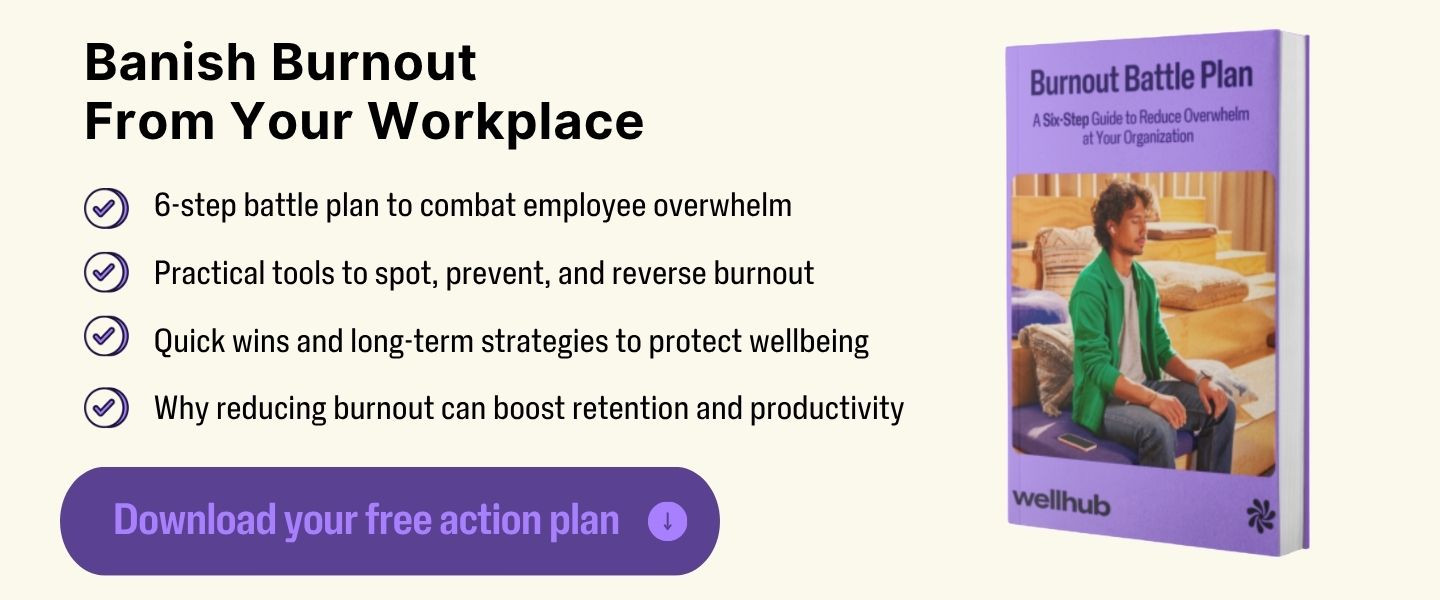
What You'll Learn
- The exact environmental, organizational, and leadership-driven triggers that fuel chronic workplace stress — and how to spot them before they damage morale.
- The measurable ways chronic stress hurts your bottom line, from rising healthcare costs to costly turnover.
- Clear physical, mental, and behavioral signs HR and managers can track to intervene early.
- Seven research-backed strategies that protect employee wellbeing while boosting productivity, retention, and company reputation.
What Is Chronic Workplace Stress?
Chronic workplace stress is ongoing stress that persists for weeks, months, or even years without relief or resolution.
Employees under this type of stress feel constantly “switched on,” unable to recharge even when the workday is over. This type of stress stems from ongoing exposure to environmental, organizational, and interpersonal situations that cause the body to release stress hormones. This type of stress can cause significant wear and tear on the mind and body.
Scientists believe that the stress system was not designed to constantly be “on.” This overuse may lead to burnout, physical illness, and mental health struggles. For the organization, this often means lower productivity, higher absenteeism, and weaker overall organizational performance.
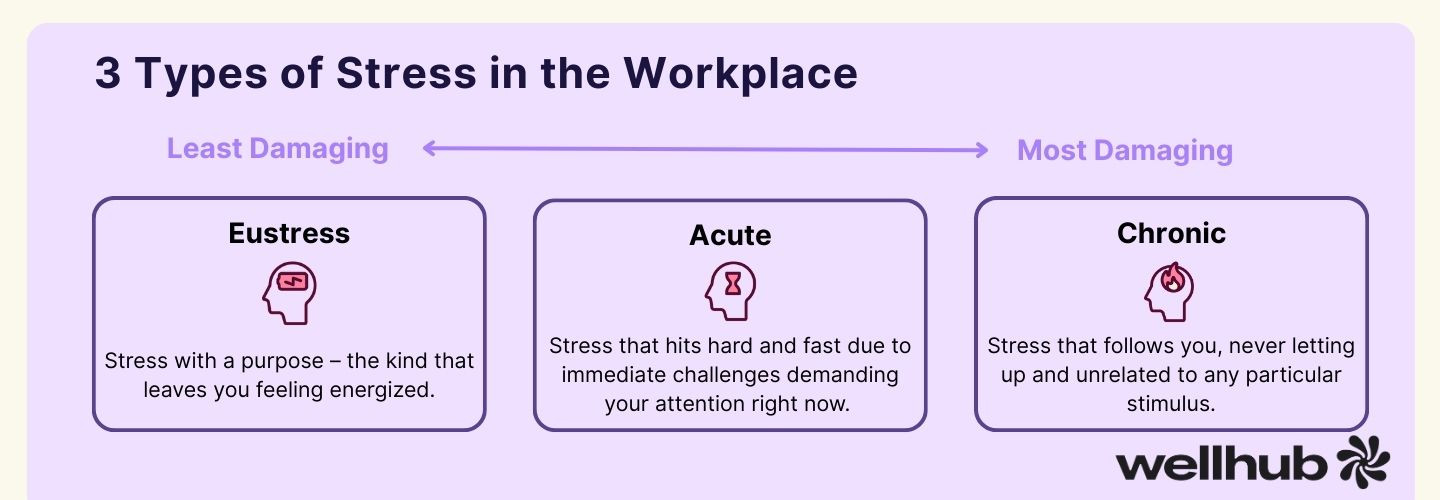
How Chronic Workplace Stress Weakens Your Organization
It’s easy to view chronic job stress as an individual factor caused by employees’ personal lives or their inability to balance work and personal life. However, it’s not just a one-time thing. The consequences of chronic workplace stress can have a ripple effect throughout the organization.
Chronic workplace stress can weaken your organization through:
- Declining productivity: Employees lose focus, make more mistakes, and need more time to complete tasks.
- Higher absenteeism: Stress-related illnesses, like migraines and anxiety, may lead to more sick days and stress leave.
- Escalating healthcare costs: Chronic stress can increase the likelihood of cardiovascular problems, sleep disorders, and depression.
- Lower retention rates: Employees leave when work causes constant burnout, leading to high turnover and low retention rates.
- Damaged reputation: Dissatisfied employees are more likely to post about their negative experiences, discouraging potential recruits from even applying in the first place. This can make talent acquisition much harder.
Stress is costing companies more than ever. Find out how to stop it before it harms performance.
Common Causes of Chronic Stress in the Workplace
Chronic stress is rarely caused by a single issue. Most often, it builds gradually due to different stressors stacking on top of each other. These stressors can be split into two broad categories: environmental and organizational triggers, and leadership and culture-based triggers.
Environmental and Organizational Triggers
Environmental and organizational triggers are logistical or structural aspects of a workplace that make it harder for employees to balance their workloads. These triggers come from how work is assigned, managed, and supported. If they aren’t fixed, they can add to chronic workplace stress.
Here are some common examples of environmental and organizational triggers:
- Heavy or unbalanced workloads: When employees are consistently assigned more tasks than they can reasonably complete in a standard day, they’re forced to make trade-offs. This means working long hours, sacrificing quality, or both. Over time, this leads to fatigue, frustration, and a drop in performance.
- Constantly changing priorities: Employees may spend days focused on one goal, only to have leadership abruptly assign new tasks or state new requirements. These rapid pivots erode trust, breed resentment, and drain motivation, especially when goals are unstable, unrealistic, or poorly communicated.
- Lack of clarity around job roles and expectations: Without a clear understanding of their responsibilities, employees may overwork to avoid being perceived as underperforming. This problem can worsen when teams are understaffed or rely on outdated tools, making even routine tasks more time-consuming and stressful.
- Blurred work-life boundaries: Digital tools like Slack and email may keep employees in “work mode” long after office hours. Without clear boundaries, the mind and body don’t get the recovery they need, leading to chronic exhaustion and eventual burnout.
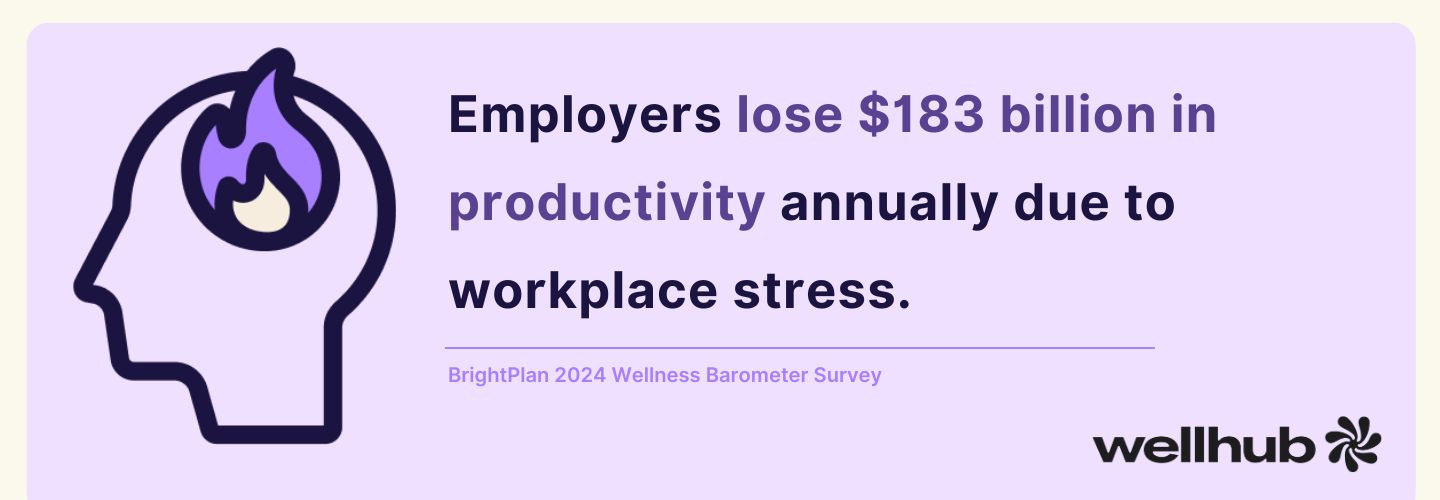
Leadership and Culture-Based Triggers
Leadership and culture-based triggers come from how a company’s leaders behave and the values they reward or discourage. Even in well-resourced environments, poor leadership or an unhealthy culture can create persistent stress that chips away at employees’ wellbeing.
Examples of such triggers include:
- Micromanagement or lack of trust in employees: When managers control every or most step of an employee’s work, employees feel like they aren’t trustworthy or capable. This can affect their confidence and motivation, leading to withdrawal from team dynamics, resentment, anxiety, absenteeism, and presenteeism.
- Poor communication from leadership: When leaders fail to set clear expectations or share important updates, employees are left guessing about what’s important. This can lead to confusion, duplicated work, and missed deadlines.
- A culture that rewards overwork: When skipping vacations, staying late, or being constantly available is seen as a badge of honor, employees may be pressured to sacrifice rest to rise in the company’s rankings or even remain employed.
- Job insecurity from layoffs or restructuring: Employees who witness layoffs, restructuring, and budget cuts are more likely to experience prolonged anxiety. This ongoing uncertainty can make it hard to focus on long-term goals.
- Lack of recognition for contributions: When hard work goes unacknowledged or unnoticed, employees may feel invisible, leading to disengagement and a loss of motivation.
Spot the signs of stress before they spiral. Discover the key symptoms and their solutions.
How Chronic Stress Impacts Employee Health and Performance
Chronic stress can cause physical and psychological symptoms, with effects often spilling over into every aspect of an employee’s life.
Physical Symptoms
Chronic stress can cause a wide range of physical symptoms. These include:
- Persistent fatigue that doesn’t go away with a good night’s sleep
- Frequent headaches
- Muscle and joint pain, even arthritis and fibromyalgia
- Gastrointestinal and digestive problems, such as stomach pain
- High blood pressure or heart palpitations
- A weakened immune system
- Missed periods
- Weight gain, since cortisol can slow the metabolism
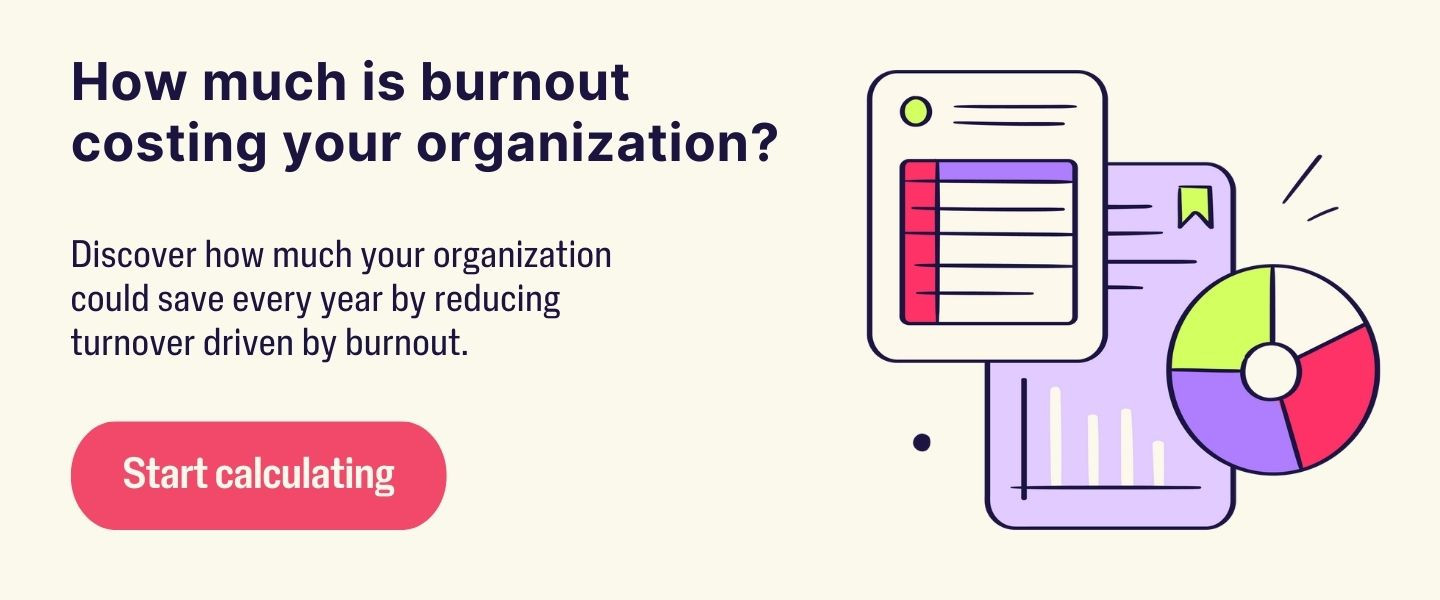
Mental and Emotional Signs
Besides physical symptoms, chronic stress also leads to mental and emotional strain. Signs include:
- Irritability or mood swings
- Difficulty concentrating
- Loss of motivation
- Feelings of helplessness or detachment
- Burnout and loss of engagement
- Depression, anxiety, and other mental health challenges
In the workplace, these symptoms show up as missed deadlines, decreased collaboration, and lower-quality output. If left unchecked, severe chronic stress can push people to disengage completely, either through presenteeism or quitting.
Key Signs of Workplace Stress HR Should Know
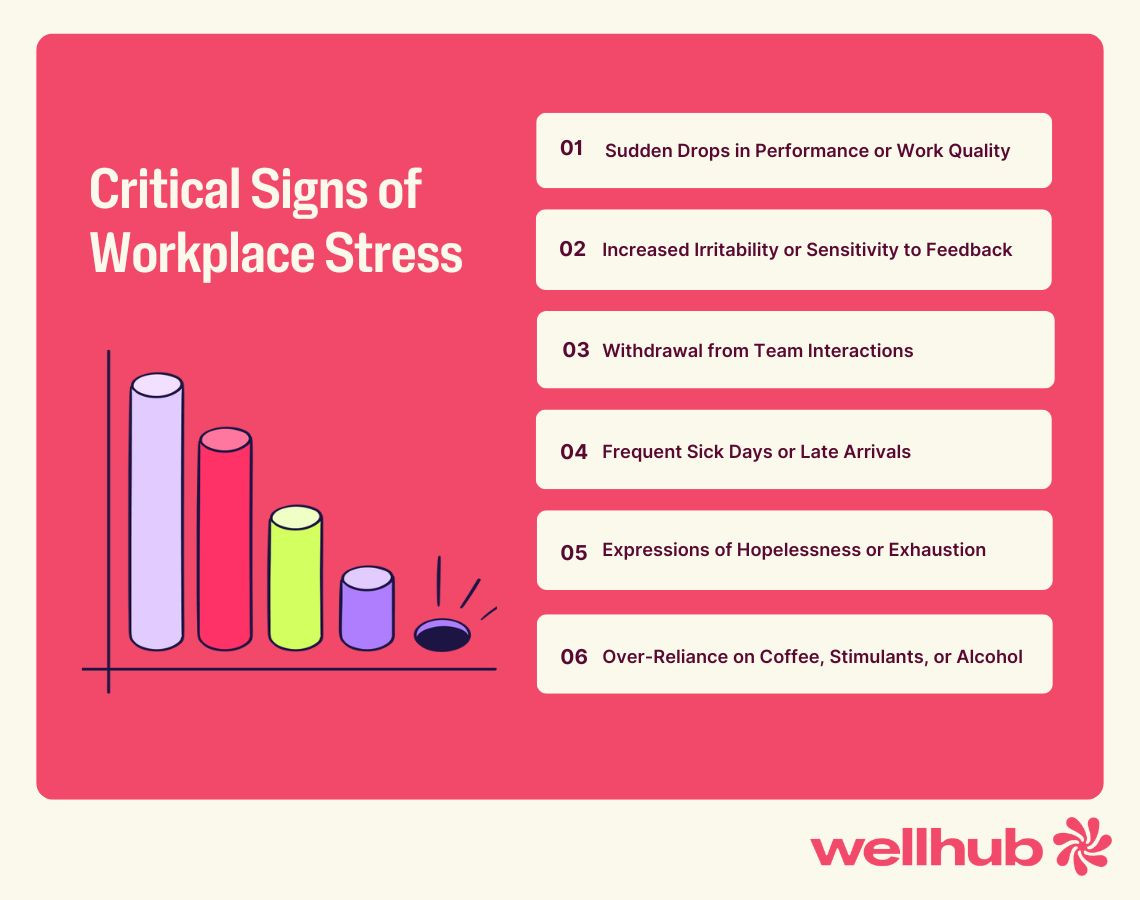
Because HR teams and managers engage with employees on a day-to-day basis, they’re well-positioned to spot early signs of chronic workplace stress before it snowballs into a crisis.
Here are five key signs of chronic stress at work that HR and managers should look for:
- Increased absenteeism or tardiness: Employees under chronic stress may come in late or take more sick days due to mental health concerns or illness.
- Drops in productivity or work quality: Stressed employees may not have the emotional or physical bandwidth to produce high-quality work, despite unchanged workload complexity.
- Withdrawal from team interactions: Stressed workers may stop contributing in meetings, avoid social gatherings, or limit communication to the bare minimum.
- Unexplained conflicts:Stress can cause irritability and frustration, straining workplace relationships.
- Frequent health complaints or requests for sick leave: While these can point to other factors, such as personal life issues, they may point to underlying stress issues. This is especially true if complaints happen over a long period, like several months.
HR and managers can spot these signs through the following:
- Regular employee surveys: Anonymous surveys can reveal patterns in stress levels, engagement, and morale that employees may not feel comfortable saying in person.
- One-on-one check-ins: Private conversations give managers the chance to build trust and provide support before problems worsen.
- Monitoring turnover rates: Sudden spikes in resignations and disengagement in certain teams can signal deeper workload and cultural issues that need fixing.
7 Proven Strategies to Reduce Chronic Stress at Work
Severe stress at work can be reduced through intentional, ongoing effort from the top down. Here are seven proven strategies to reduce chronic stress from work.
- Encourage Work-Life Wellness
Vacation days are just one part of work-life wellbeing. It also requires building a culture where people actually feel empowered to use their time off. As such, you should promote flexible scheduling and hybrid work arrangements to give employees more control over their time.
Additionally, enforce no-email-after-hours policies to send a clear message that rest is a must. Leaders should model these behaviors to set the tone for the whole company.
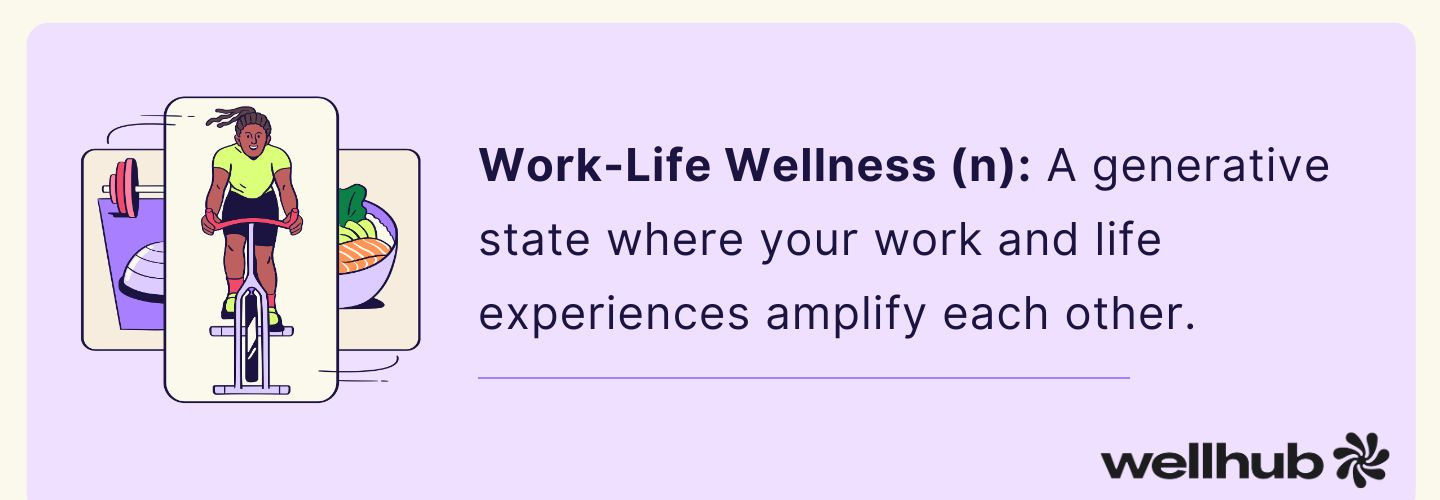
- Promote Manager Training on Mental Health
Managers are often the first to notice changes in an employee’s behavior. However, without the right tools, they may not respond in the right way. Training leaders to recognize early signs of stress, build emotional intelligence, and foster empathetic communication can make a huge difference in employee wellbeing.
Consider providing resources for managers — such as referral information for mental health professionals or guidance on handling sensitive conversations. This gives managers the tools and the confidence to support their teams effectively while avoiding stigma.
- Offer Wellness Programs
Many companies already offer gym memberships, but wellness programs go beyond just that. They also provide access to:
- Mental health professionals and therapy: This gives employees a safe, confidential space to talk about specific challenges, develop coping strategies, and prevent burnout.
- Coaching: This helps individuals set goals, build confidence, and develop problem-solving skills.
- Fitness, nutrition, and mindfulness tools: These improve energy, mood, and overall health, making employees better equipped to handle stress over time.
- Reevaluate Workload Distribution
Even the most motivated employees can burn out if they’re always overloaded. Here’s what you should do to reevaluate workload distribution:
- Regularly audit workloads to identify bottlenecks and prevent long-term imbalances.
- Adjust timelines and expectations during high-demand periods.
- Use project management tools to visualize workloads, spot inefficiencies, and make sure no one carries unfair burdens.
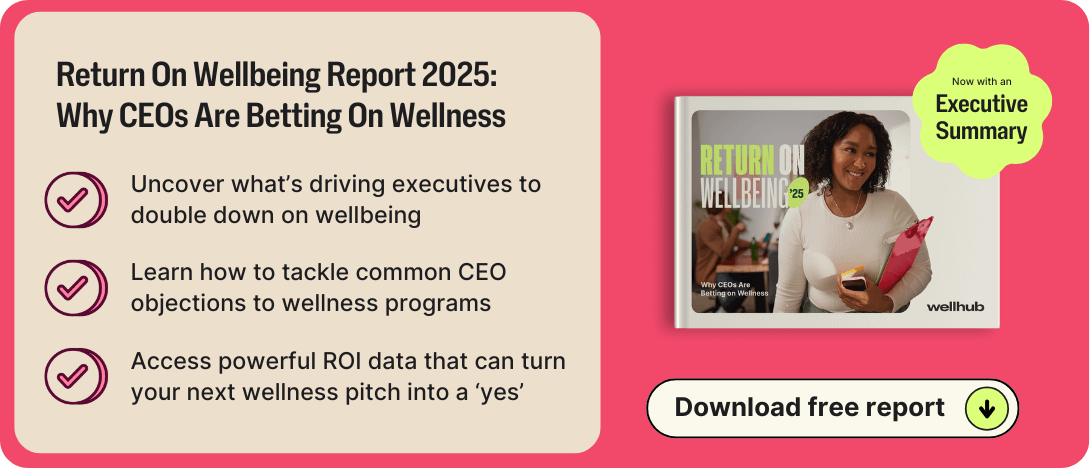
- Improve Communication and Transparency
Poor communication can amplify workplace stress. To improve communication and transparency, hold regular team check-ins where people can raise concerns and ask questions. Leaders should also share updates on company goals and changes frequently and openly to reduce uncertainty.
Additionally, they should avoid last-minute surprises, especially those that change deadlines or priorities. This will give employees the predictability they need to plan effectively and feel in control of their work.
- Create Opportunities for Autonomy and Growth
When you trust employees to make decisions about their work, they feel more in control and are more naturally invested in the outcome. Supporting career development through training and mentorship further builds confidence and engagement.
- Foster a Culture of Psychological Safety
In a psychologically safe workplace, employees are more likely to feel comfortable voicing concerns, admitting mistakes, and suggesting improvements without fear of retaliation or judgment. Leaders can set this tone by responding constructively when challenges arise. Over time, this openness builds collaboration, trust, and resilience across the company.
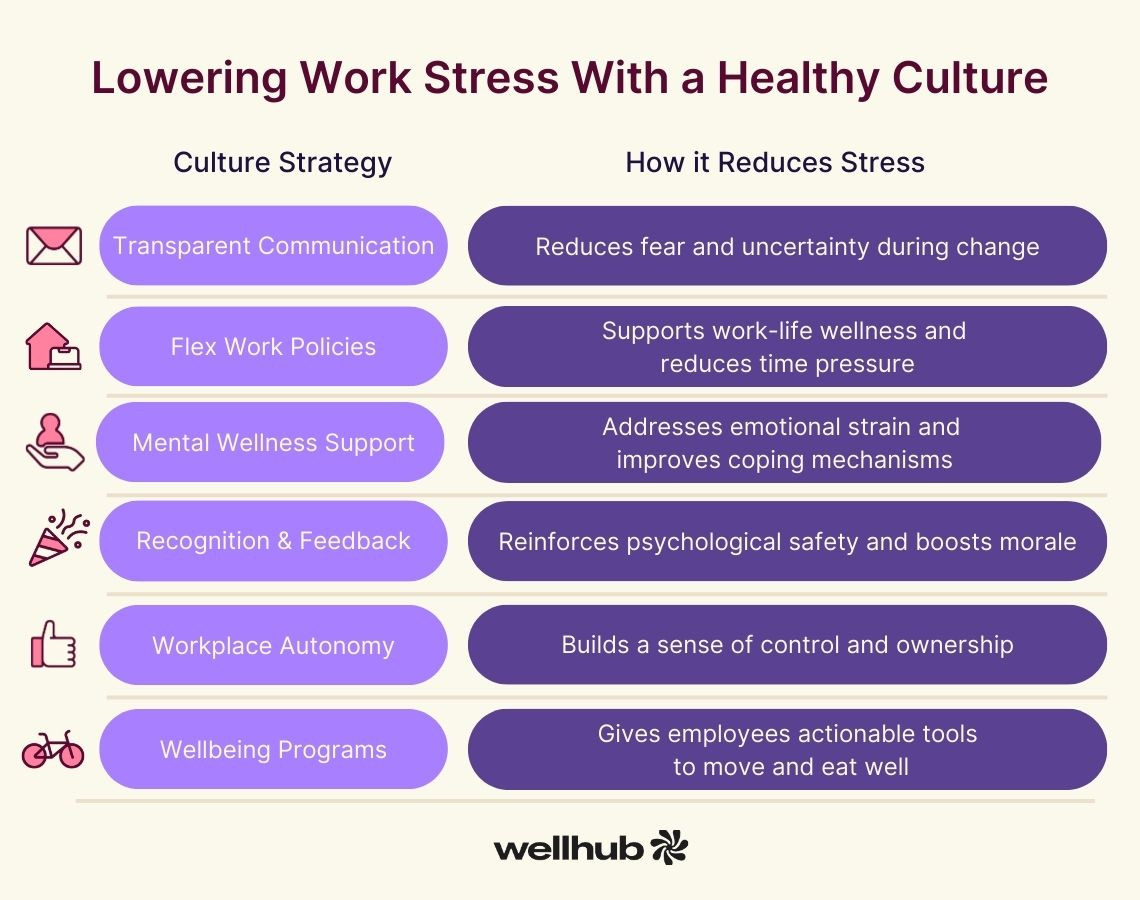
Combat Chronic Workplace Stress with a Stronger Approach to Employee Wellbeing
Chronic workplace stress drains employee energy, lowers productivity, and leads to burnout. It stems from heavy workloads, poor communication, and a culture that undervalues rest and recognition. When left unchecked, it damages both employee health and company performance.
A strategic wellbeing program can turn this around. Giving employees access to mental health support, fitness options, and mindfulness tools helps them recover, recharge, and perform at their best.
Speak with a Wellhub Wellbeing Specialist to reduce stress, boost performance, and help your team thrive.

Company healthcare costs drop by up to 35% with Wellhub*
See how we can help you reduce your healthcare spending.
[*] Based on proprietary research comparing healthcare costs of active Wellhub users to non-users.
Category
Share

The Wellhub Editorial Team empowers HR leaders to support worker wellbeing. Our original research, trend analyses, and helpful how-tos provide the tools they need to improve workforce wellness in today's fast-shifting professional landscape.
Subscribe
Our weekly newsletter is your source of education and inspiration to help you create a corporate wellness program that actually matters.
Subscribe
Our weekly newsletter is your source of education and inspiration to help you create a corporate wellness program that actually matters.
You May Also Like

FSA vs. HSA Strategy for HR Leaders | Wellhub
Compare FSA vs HSA rules, tax advantages, eligibility, and rollover differences to help employees choose the right account and avoid costly compliance issues.

Employee Wellness Programs: Key Components for Success | Wellhub
Transform your workplace wellness strategy by integrating physical, mental, financial, and social wellbeing into a comprehensive wellness program that works

Benefits Strategy Roadmap: Pull and Retain Top Talent | Wellhub
Support wellbeing, reduce turnover, and maximize ROI with a benefits strategy built for today’s workforce—not yesterday’s spreadsheet.